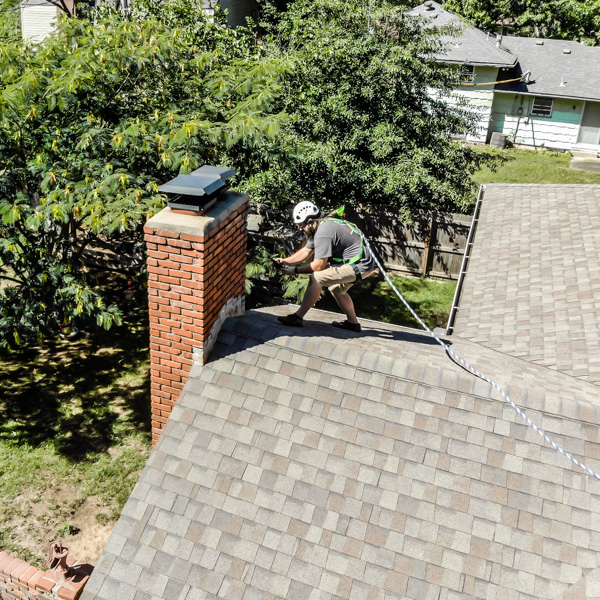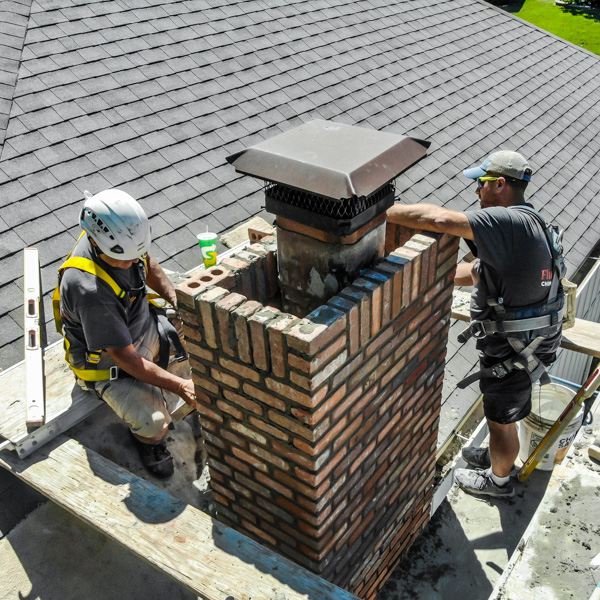Chimney 101: How Tall Should Your Chimney Be?
Spring may have sprung, but it’s never too early to think about winter and how you’ll keep your family warm and cozy, especially if you’re installing a heating system like a fireplace up upgrading your chimney. A chimney’s height is important for proper drafting and efficient heating, and in this post, we look at how tall your chimney should be.
 Factors to Consider Regarding Chimney Height
Factors to Consider Regarding Chimney Height
Whether you’re installing a new chimney or rebuilding an old one, you must consider certain factors to ensure it’s perfectly sized for your needs.
The first thing to consider is the fuel you’ll burn. Different fuels require different heights to produce heat efficiently and burn thoroughly. For example, traditional masonry wood-burning fireplaces typically require a taller chimney than those that burn natural gas.
The second factor to consider is the claimant you live in. If you live in a windy area, you’ll need a taller chimney to prevent downdrafts. Downdrafts cause smoke to flow down the chimney back into the home. On the flip side, if you live in a dry climate, you can get by with a shorter chimney.
The third factor to consider is how big your fireplace is. If you have a small fireplace, the chimney won’t need to be as tall as a large one.
Finally, you’ll need to account for your home’s size. Larger homes require taller chimneys than smaller ones because taller chimneys are better for drafting and drawing smoke out of the house.
What is the Recommended Chimney Height?
As you can see, many factors will influence the height of your chimney, so no one answers right for every situation. However, experts refer to the 10-2 rule to determine the proper chimney height. The 10-2 rule is a guideline used in the construction industry for determining the appropriate height of a chimney based on the roof pitch.
The rule suggests that the chimney height should be at least 3 feet (10% of the distance) taller than any roof or object within a 10-foot (3-meter) horizontal distance from the chimney. Additionally, the chimney height should be at least 2 feet taller than any point on the roof within a horizontal distance of 20 feet from the chimney.
For example, if the roof is 20 feet high at its highest point and the chimney is 10 feet (3 meters) away from the roof, the chimney should be at least 5 feet taller than the roofline (10% of 20 feet = 2 feet; 2 x 2 feet = 4 feet, rounded up to 5 feet). The 10-2 rule is not a legal requirement, but it is often used as a guideline to ensure proper ventilation and reduce the risk of fire hazards. It is important to check local building codes and regulations to determine the specific requirements for chimney height in your area.
How to Measure Chimney Height
We’ve established the importance of chimney height, so let’s look at how to measure it properly. The overall chimney height determines the size and type of flue you’ll need and the installation cost. You can measure chimney height in a few different ways. The first way is from the ground up; this is the most common method, and it’s also the easiest. To do this, measure the distance from the ground to the top of your chimney. This will give you the height of your chimney in feet.
If you can’t measure from the ground up, you can also measure from the top down. This is a bit more difficult, but it’s still possible. To do this, you’ll need to find a point on your roof that’s level with the top of your chimney. Once you’ve found this point, measure down from it to the bottom of your chimney. This will give you the height of your chimney in feet. Once you have your measurements, you can decide on the appropriate flue size and type for your home. If you’re unsure what size or type of flue you need, consult a professional chimney contractor before making any decisions.
What You Should Know About Building Codes
The fact is that many chimneys aren’t code-compliant and fail to meet the minimum height requirements for safety and efficiency, better known as the 3-2-10 rule. This rule means that the chimney’s shortest side needs to be at least 3 feet above roof penetration, and its top has to be 2 feet higher than any part of the building within 10 feet. This might seem arbitrary, but it’s crucial to prevent flames or burning creosote from igniting your roof and ensure proper drafting for a more efficient and safe fire.
 Let the Fluesbrothers Chimney & Fireplace Handle Your Chimney Repairs
Let the Fluesbrothers Chimney & Fireplace Handle Your Chimney Repairs
Whether you’re repairing or rebuilding your chimney, trust the professionals at Fluesbrothers Chimney & Fireplace. Our founder is a CSIA-certified master chimney sweep, and we have over a decade of experience. We’re a full-service chimney company serving residents throughout the Kansas City area. We’re also members in good standing with the National Chimney Sweep Guild and fully certified by the Chimney Safety Institute of America and the National Fireplace Institute. Contact us today at 913-236-7141.
The post Chimney 101: How Tall Should Your Chimney Be? appeared first on Fluesbrothers Chimney Service.